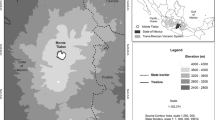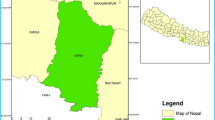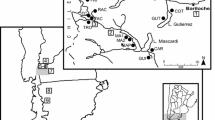Abstract
Seventeen tree-ring chronologies from the conifer Araucaria araucana (Molina) K. Koch have been analyzed across its range of distribution in Argentina. We studied the growth patterns and determined the main climatic factors influencing A. araucana radial growth. All the chronologies show a strong common signal observed by the high amount of variance explained by the first principal component (PC1) and the high mean correlation (r = 0.597) between the chronologies over the 1676–1974 interval. On this basis, we developed a regional chronology that is 866 years long (A.D. 1140–2006) and includes 621 tree-ring series. Based on the PC2 scores, chronologies were clearly separated by elevation in high- and low-elevation records. Regional tree growth is strongly negatively related to temperatures during summer and fall in the previous-growing season and spring in the current-growing season, respectively. A positive association of tree growth with precipitation is recorded during spring in the current growing season. These results suggest a close relationship between A. araucana tree growth and water availability on a regional scale. This observation is also consistent with a positive and significant correlation between our A. araucana regional record and a reconstruction of November–December rainfall for northern Patagonia inferred from the xeric Austrocedrus chilensis during the past 400 years. Negative correlations between A. araucana regional growth and the sea surface temperature in the Niño 3.4 region reflect the occurrence of above-mean summer temperatures in the region during positive tropical Pacific SST anomalies. The negative relationship with the Antarctic Oscillation (AAO) results from reduced precipitation in our study region during the positive phase of the AAO. The effect of elevation on water availability is consistent with significant correlations between ring-width variations at lower elevations and the Palmer Drought Severity Index during spring and summer in the current growing season. Our study emphasizes the high dendroclimatological potential of A. araucana chronologies for reconstructing past climate variations in northern Patagonia during the past millennium.












Similar content being viewed by others
Notes
The International Tree-Ring Data Bank (ITRDB) held at the World Data Center for Paleoclimatology website (NOAA Paleoclimatology Program, http://www.ncdc.noaa.gov/paleo/treering.html).
Convention on International Trade in Endangered Species of Wild Fauna and Flora.
The Niño 3.4 region is the tropical Pacific extending from 5° N to 5° S, and from 170° to 120° W). We used the updated series available from the website of the Global and Climate Dynamics of the National Centre for Atmospheric Research (http://www.cgd.ucar.edu/cas/catalog/climind/TNI_N34/index.html).
The series available from the website of the Joint Institute for the Study of the Atmosphere and Ocean (JISAO) of the University of Washington was used (http://jisao.washington.edu/data/aao/).
References
Aceituno P (1988) On the functioning of the Southern Oscillation in the South American sector. Part I: surface climate. Mon Weather Rev 106:505–524
Aravena JC, Luckman BH (2009) Spatio-temporal rainfall patterns in southern South America. Int J Climatol 29:2106–2120
Blasing TJ, Solomon AM, Duvick DN (1984) Response function revisited. Tree-Ring Bull 44:1–15
Boninsegna JA, Argollo J, Aravena JC, Barichivich J, Christie D, Ferrero ME, Lara A, Le Quesne C, Luckman BH, Masiokas M, Morales M, Oliveira JM, Roig F, Srur A, Villalba R (2009) Dendroclimatological reconstructions in South America: a review. Palaeogeogr Palaeoclimatol Palaeoecol 281:210–228
Buckley BM, Cook ER, Peterson MJ, Barbetti M (1997) A changing temperature response with elevation for Lagostrobos franklinii inTasmania, Australia. Clim Chang 36:477–498
Christensen JH, Hewitson B, Busuioc A, Chen A, Gao X, Held I, Jones R, Kolli RK, Kwon W-T, Laprise R, Magaña Rueda V, Mearns L, Menéndez CG, Räisänen J, Rinke A, Sarr A, Whetton P (2007) Regional climate projections. In: Solomon S, Qin D, Manning M, Chen Z, Marquis M, Averyt KB, Tignor M, Miller HL (eds) Climate change 2007: the physical science basis. Contribution of working group I to the fourth assessment report of the Intergovernmental Panel on Climate Change. Cambridge University Press, Cambridge
Christie D, Boninsegna J, Cleaveland M, Lara A, Le Quesne C, Morales M, Mudelsee M, Stahle D, Villalba R (2010) Aridity changes in the Temperate-Mediterranean transition of the Andes since AD 1346 reconstructed from tree-rings. Clim Dyn 36:1505–1521
Cook ER (1985) A time series analysis approach to tree ring standardization. Ph.D. dissertation, University of Arizona, Tucson
Cook ER, Jacoby GC Jr (1977) Tree-ring-drought relationships in the Hudson Valley, New York. Science 198:399–401
Cook ER, Pederson N (2011) Uncertainty, emergence and statistics in dendrochronology. In: Hughes MK, Swetnam TW, Diaz HF (eds) Dendroclimatology: progress and prospects. Developments in paleoenvironmental research. Springer, Dordrecht
Cook ER, Briffa K, Shiyatov S, Mazepa V (1990) Tree-ring standardization and growth-trend estimation. In: Cook E, Kairiukstis LA (eds) Methods of dendrochronology—applications in the environmental sciences. Kluwer Academic, Amsterdam
Cook ER, Meko DM, Stahle DW, Cleaveland MK (1999) Drought reconstructions for the continental United States. J Clim 12:1145–1162
Cooley WW, Lohnes PR (1971) Multivariate data analysis. Wiley, New York
Dai A, Trenberth KE, Qian T (2004) A global dataset of Palmer drought severity index for 1870–2002: relationship with soil moisture and effects of surface warming. J Hydrometeorol 5:1117–1130
Diaz HF, Markgraf V (2000) El Niño and the Southern Oscillation: multiscale variability, global and regional impacts. Cambridge University Press, Cambridge
Fritts HC (1976) Tree rings and climate. Academic Press, London
Fritts HC, Smith DG, Cardis JW, Budelsky CA (1965) Tree-ring characteristics along a vegetation gradient in northern Arizona. Ecology 46:393–400
Garreaud RD, Vuille M, Compagnucci R, Marengo J (2009) Present-day South American climate. Palaeogeogr Palaeoclimatol Palaeoecol 281:180–195
Holmes RL (1983) Computer-assisted quality control in tree-ring dating and measurement. Tree-Ring Bull 43:69–75
Holmes RL, Stockton CW, LaMarche VC (1979) Extension of river flow records in Argentina from long tree-ring chronologies. J Am Water Resour As 15:1081–1085
Hughes MK, Xiangding W, Xuemei S, Garfin GM (1994) A preliminary reconstruction of rainfall in north-central China since A.D. 1600 from tree-ring density and width. Quat Res 42:88–99
Labraga JC (1998) Escenario de cambio climático para la Argentina. Ciencia Hoy 8:18–25
LaMarche VC, Holmes RL, Donwiddie P, Drew L (1979) Tree-ring chronologies of the southern hemisphere: 1. Argentina. Chronology Series V, vol 1. University of Arizona, Tucson
Lara A, Aravena JC, Villalba R, Wolodarsky-Franke A, Luckman BH, Wilson R (2001) Dendroclimatology of high-elevation Nothofagus pumilio forests at their northern distribution limit in the central Andes of Chile. Can J For Res 31:925–936
Lara A, Villalba R, Wolodarsky-Franke A, Aravena JC, Luckman BH, Cuq E (2005) Spatial and temporal variation in Nothofagus pumilio growth at tree line along its latitudinal range (35°45′-55° S) in the Chilean Andes. J Biogeogr 32:879–893
Leal S, Melvin TM, Grabner M, Wimmer R, Briffa KR (2007) Tree-ring growth variability in the Austrian Alps: the influence of site, altitude, tree species and climate. Boreas 36:426–440
Massaccesi G, Roig FA, Martínez Pastur GJ, Barrera MD (2008) Growth patterns of Nothofagus pumilio trees along altitudinal gradients in Tierra del Fuego, Argentina. Trees Struct Funct 22:245–255
Meko D, Cook ER, Stahle DW, Stockton CW, Hughes MK (1993) Spatial patterns of tree-growth anomalies in the United States and southeastern Canada. J Climate 6:1773–1786
Mundo IA, El Mujtar V, Perdomo M, Gallo L, Villalba R, Barrera M (2010) Austrocedrus chilensis growth decline in relation to drought events in northern Patagonia, Argentina. Trees Struct Funct 24:561–570
Norton DA (1985) A dendrochronological study of Nothofagus solandri tree growth along an elevational gradient, South Island, New Zealand. In: Turner H, Tranquillini W (eds) Establishment and tending of subalpine forests: research and management. Eidgenössische Anstalt für das forstliche Versuchswesen, Berichte
Palmer JG (1965) Meteorological drought. U.S. Department of Commerce, Washington, D.C
Peters K, Jacoby GC, Cook ER (1981) Principal components analysis of tree-ring sites. Tree-Ring Bull 41:1–19
Richter K, Eckstein D (1990) A proxy summer rainfall record for southwest Spain derived from living and historic pine trees. Dendrochronologia 8:67–82
Rigling A, Bräker O, Schneiter G, Schweingruber F (2002) Intra-annual tree-ring parameters indicating differences in drought stress of Pinus sylvestris forests within the Erico-Pinion in the Valais (Switzerland). Plant Ecol 163:105–121
Ropelewski CF, Jones PD (1987) An extension of the Tahiti–Darwin Southern Oscillation index. Mon Weather Rev 115:2161–2165
Schmelter A (2000) Climatic response and growth-trends of Nothofagus pumilio along altitudinal gradients from arid to humid sites in northern Patagonia—a progress report. In: Roig Juñent FA (ed) Dendrocronología en América Latina. EDIUNC, Mendoza
Schulman E (1956) Dendroclimatic changes in semiarid America. University of Arizona Press, Tucson
Software Golden (2002) Surfer 8 for Windows: user’s guide. Golden, Colorado
Splechtna BE, Dobrys J, Klinka K (2000) Tree-ring characteristics of subalpine fir [Abies lasiocarpa (Hook.) Nutt.] in relation to elevation and climatic fluctuations. Ann For Sci 57:89–100
Stahle DW, Cleaveland MK (1988) Texas drought history reconstructed and analyzed from 1698 to 1980. J Climate 1:59–74
Stahle DW, Cleaveland MK (1992) Reconstruction and analysis of spring rainfall over the Southeastern U.S. for the past 1000 years. B Am Meteorol Soc 73:1947–1961
Stokes M, Smiley T (1968) An introduction to tree-ring dating. University of Chicago Press, Chicago
Thompson DWJ, Wallace JM (2000) Annular modes in the extratropical circulation. Part I: Month-to-month variability. J Climate 13:1000–1016
Till C, Guiot J (1990) Reconstruction of precipitation in Morocco since 1100 A.D. Based on Cedrus atlantica tree-ring widths. Quat Res 33:337–351
Tortorelli LA (1956) Maderas y bosques argentinos. Editorial Acme, Buenos Aires
Tranquillini W (1979) Physiological ecology of the alpine timberline: tree existence in high altitudes with special reference to the European alps. Ecological studies 31. Springer, Berlin
Trenberth KE, Stepaniak DP (2001) Indices of El Niño evolution. J Climate 14:1697–1701
Veblen TT, Burns BR, Kitzberger T, Lara A, Villalba R (1995) The ecology of the conifers of southern South America. In: Ecology of the Southern Conifers. Melbourne University Press, Parkville
Villalba R (1995) Geographical variations in the tree-growth responses to climate in the Southern Andes. In: Argollo J, Mourguiart P (eds) Cambios cuaternarios en América del Sur. ORSTOM-HISBOL, La Paz
Villalba R, Veblen TT (1997) Spatial and temporal variation in Austrocedrus growth along the forest-steppe ecotone in northern Patagonia. Can J For Res 27:580–597
Villalba R, Boninsegna JA, Cobos DR (1989) A tree-ring reconstruction of summer temperature between A.D. 1500 and 1974 in western Argentina. In: Third international conference on Southern Hemisphere Meteorology & Oceanography, Buenos Aires
Villalba R, Boninsegna JA, Veblen TT, Schmelter A, Rubulis S (1997) Recent trends in tree-ring records from high elevation sites in the Andes of Northern Patagonia. Clim Chang 36:425–454
Villalba R, Cook ER, Jacoby GC, D’Arrigo R, Veblen TT, Jones PD (1998) Tree-ring based reconstruction of northern Patagonia precipitation since AD 1600. Holocene 8:659–674
Wang T, Ren H, Ma K (2005) Climatic signals in tree ring of Picea schrenkiana along an altitudinal gradient in the central Tianshan Mountains, northwestern China. Trees-Struct Funct 19:736–742
Wigley TML, Briffa K, Jones PD (1984) On the average value of correlated time series, with applications in dendroclimatology and hydrometeorology. J Clim Appl Meteorol 23:201–213
Wilson RJS, Luckman BH, Esper J (2005) A 500 year dendroclimatic reconstruction of spring–summer precipitation from the lower Bavarian forest region, Germany. Int J Climatol 25:611–630
Yamaguchi DK (1991) A simple method for cross-dating increment cores from living trees. Can J For Res 21:146–414
Acknowledgments
This research was supported by the Inter-American Institute for Global Change Research (IAI-CRN 2005 and 2047) and by a CONICET doctoral fellowship (National Council for Scientific and Technical Research of Argentina). We are grateful to Eduardo Barrio, Alberto Ripalta, Lidio López, María Alejandra Giantomasi, Sergio Piraino, Ana Srur, Carolina Szymañsky and Andrés Manceñido for research assistance. We thank the Administración de Parques Nacionales, Áreas Naturales Protegidas del Neuquén, Corporación Interestadual Pulmarí, and the owners and administrators of Ea. Nahuel Mapi and Rahue site for facilitating this research. We are greatly indebted to Brian Luckman for comments and corrections on an early version of this manuscript. We also thank the communicating editor and two anonymous reviewers for helping to improve the final version of this manuscript.
Author information
Authors and Affiliations
Corresponding author
Additional information
Communicated by S. Leavitt.
Rights and permissions
About this article
Cite this article
Mundo, I.A., Roig Juñent, F.A., Villalba, R. et al. Araucaria araucana tree-ring chronologies in Argentina: spatial growth variations and climate influences. Trees 26, 443–458 (2012). https://doi.org/10.1007/s00468-011-0605-3
Received:
Revised:
Accepted:
Published:
Issue Date:
DOI: https://doi.org/10.1007/s00468-011-0605-3




